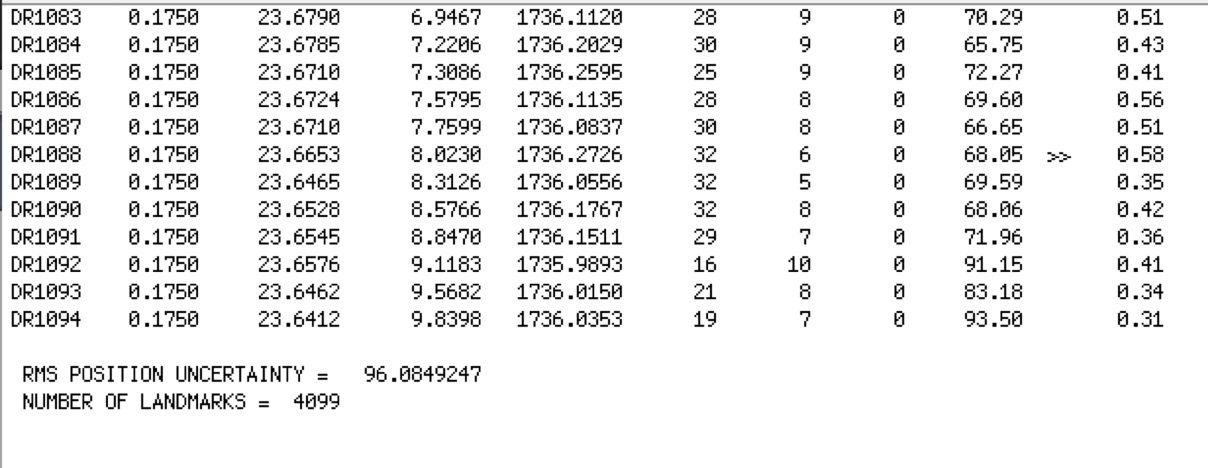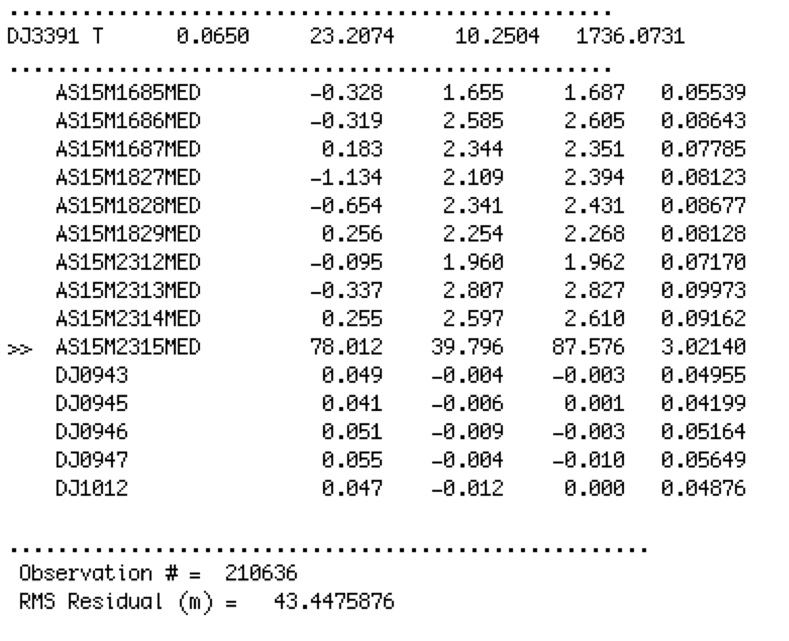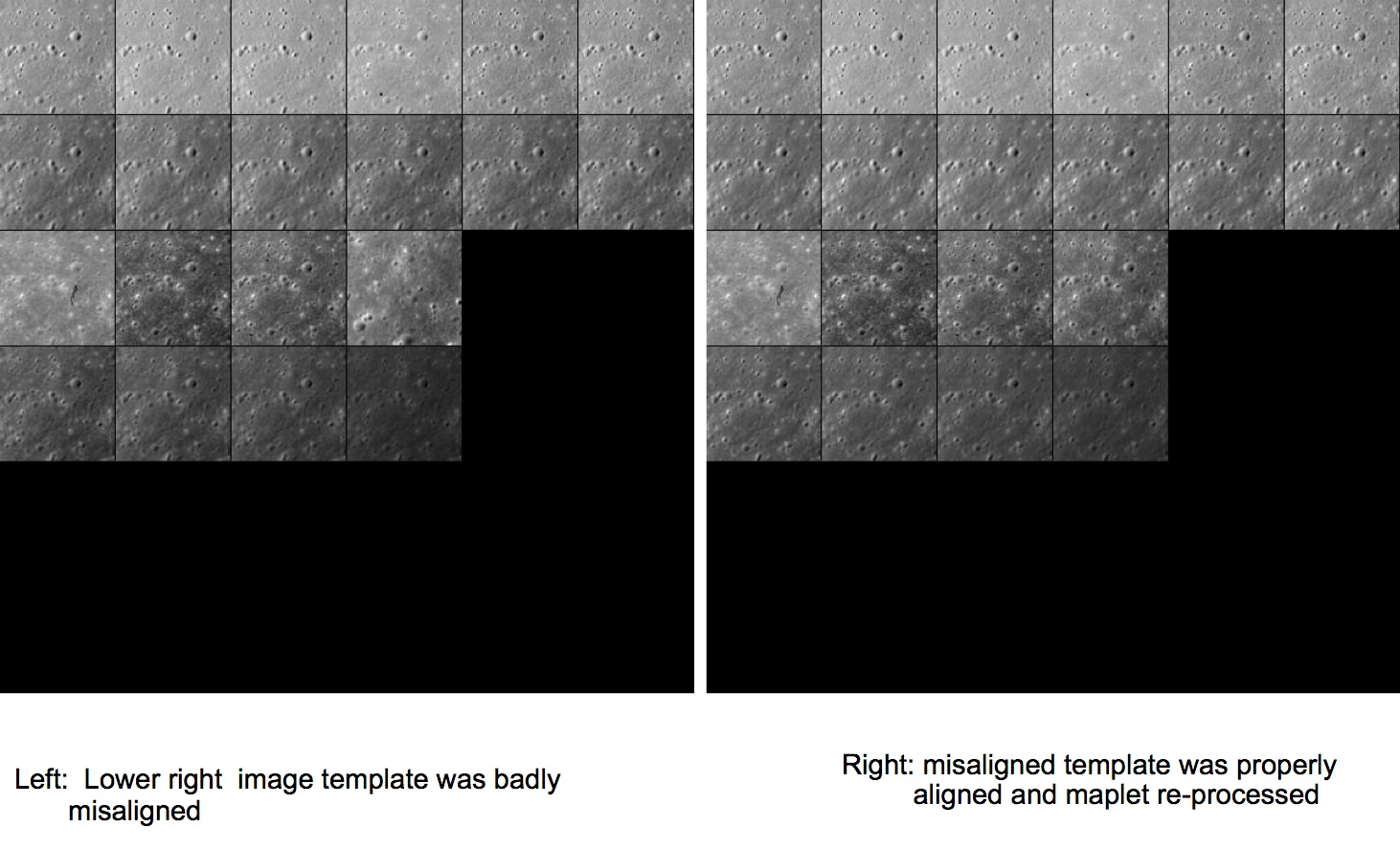|
Size: 4716
Comment:
|
Size: 5333
Comment:
|
| Deletions are marked like this. | Additions are marked like this. |
| Line 4: | Line 4: |
| Compiled by KD |
|
| Line 8: | Line 6: |
| The routine residuals tests the landmarks to look for problems and gives reports about how well the landmarks were processed. In other words, residuals shows how well SPC performed. The reports that residuals outputs are listed in the Output section. | This program shows how well SPC has performed. '''residuals''' tests the landmarks to look for problems and gives reports about how well the landmarks were processed. The reports it generates are listed in the Output section. |
| Line 10: | Line 8: |
| === Input - files === * [[LMKFILES]] * [[NOMINALS]] * [[SUMFILES]] * [[IMAGEFILES]] |
=== Input Files === * [[LMKFILES]]/ - a directory containing the full suite of landmarks * [[NOMINALS]]/ - a directory containing the image .NOM files (starting solution image, S/C and camera information) * [[SUMFILES]]/ - a directory containing the image .SUM files (updated solution image, S/C and camera information, lmrks and limbs) * [[IMAGEFILES]] - a directory containing the image .DAT files |
| Line 16: | Line 14: |
| * [[LMRKLIST.TXT]] | * [[LMRKLIST.TXT]] - a list of the landmarks contained in the solution |
| Line 19: | Line 17: |
| * [[PICTLISTS]] - user-generated list of picture names, if this file exists, it is used instead of [[PICTLIST.TXT]] === Input - stdin === * enter 3 values (px,km,km) 1. The value of the pixel residual limit. Images and maplets are flagged for a pixel residual limit greater than this. 2. The value of the linear residual beyond which images and maplets are flagged. 3. The max scale (km/px) that sets the scale for the histogram at the end of [[PICINFO.TXT]]. input operation list {{{ 10, 0.01, 0.01 }}} |
* [[PICTLISTS.TXT]] - user-generated list of picture names. (If this file exists, it is used instead of [[PICTLIST.TXT]].) |
| Line 33: | Line 20: |
| === Output === | === Output Files === |
| Line 50: | Line 37: |
| == Example of MAPINFO.TXT == | == Using residuals == After you invoke the program, it prompts: {{{ enter 3 values (px,km,km) }}} '''value 1''' - the value of the pixel residual limit. Images and maplets are flagged for a pixel residual limit greater than this. '''value 2''' - the value of the linear residual beyond which images and maplets are flagged. '''value 3''' - the max scale (km/px) that sets the scale for the histogram at the end of [[PICINFO.TXT]]. Here is a sample of inputs for '''residuals''': {{{ 10, 0.01, 0.01 }}} Here is a sample [[MAPINFO.TXT]] file: |
| Line 53: | Line 59: |
| == Example of a single landmark in RESIDUALS.TXT == | Here is a sample of a single landmark in [[RESIDUALS.TXT]]: |
| Line 56: | Line 63: |
| == What a Bad & Fixed Image Looks Like == | The following shows what a bad and a fixed image looks like: |
| Line 60: | Line 67: |
| == Qualitative Checks == The routine residuals is not the only way to check how well SPC performed. One can simply observe the maplets generated. The information below is what to look for when visually inspecting a maplet to judge its quality. |
== Additional Reference == |
| Line 63: | Line 69: |
| * Qualitative checks are important to verify that the quantitative error estimates are believable * Render a single maplet, or a DEM synthesized by a collection of maplets, at the same geometry & illumination conditions as the images themselves * Do all the features in the images appear in the DEM ? * Are the smallest discernible features in the images, e.g., boulders, craters etc. visible in the DEM as well ? * Is the relative albedo solution such that the relative brightness of adjacent image features matches that of the DEM ? * Are the heights solution such that the length and overall appearance of the shadows in the DEM matches that of the image ? |
=== Qualitative Checks === '''residuals''' is not the only way to check how well SPC performed. You can simply observe the maplets generated. |
| Line 70: | Line 72: |
| == How Uncertainties are Introduced in the Data == | Here is a list of what to look for when you visually inspect a maplet to judge its quality: |
| Line 72: | Line 74: |
| * Main types of uncertainties: * S/C trajectory, camera pointing, image timestamp * Manifest themselves mostly in the projection of image template onto the surface. Corrected by global geometry solution * Image noise, artifacts, smear, overall image quality * Manifest themselves in predicted image template brightness and in its fit to the extracted image brightness * Photometric model and reflectance function models * Show up in slopes & heights integration * Poor choice of a-priori parameters & data weights * Evident at end of each estimation step; data won’t fit well |
* Verify that the quantitative error estimates are believable. * Render a single maplet, or a DEM synthesized by a collection of maplets, at the same geometry and illumination conditions as the images themselves. * Determine if all the features in the images appear in the DEM. * Determine if the smallest discernible features in the images (e.g., boulders, craters etc.) are visible in the DEM as well. * Determine if the relative albedo solution is such that the relative brightness of adjacent image features matches that of the DEM. * Determine if the heights solution is such that the length and overall appearance of the shadows in the DEM match those of the image. |
| Line 82: | Line 81: |
| * Often above contributions are correlated; individual contributors may not be separated until many processing steps have been taken | === How Uncertainties are Introduced in the Data === |
| Line 84: | Line 83: |
| ---- | These are the main types of uncertainties and how they manifest: * S/C trajectory, camera pointing, image timestamp * Manifest themselves mostly in the projection of image template onto the surface. Corrected by global geometry solution. * Image noise, artifacts, smear, overall image quality * Manifest themselves in predicted image template brightness and in its fit to the extracted image brightness. * Photometric model and reflectance function models * Show up in slopes & heights integration * Poor choice of a-priori parameters and data weights * Are evident at the end of each estimation step. Data won’t fit well. Often the above contributions are correlated; you may not be able to separate individual contributors until you have taken many processing steps. ----------- ''(Compiled by KD)'' |
residuals
Description
This program shows how well SPC has performed. residuals tests the landmarks to look for problems and gives reports about how well the landmarks were processed. The reports it generates are listed in the Output section.
Input Files
LMKFILES/ - a directory containing the full suite of landmarks
NOMINALS/ - a directory containing the image .NOM files (starting solution image, S/C and camera information)
SUMFILES/ - a directory containing the image .SUM files (updated solution image, S/C and camera information, lmrks and limbs)
IMAGEFILES - a directory containing the image .DAT files
PICTLIST.TXT - list of picture names generated by make_sumfiles
LMRKLIST.TXT - a list of the landmarks contained in the solution
Optional Files
PICTLISTS.TXT - user-generated list of picture names. (If this file exists, it is used instead of PICTLIST.TXT.)
Output Files
check.txt - List of landmarks and overlaps for landmarks whose linear residual is greater than the user-specified limit.
EMPTY.TXT - lithos seed file for batch deletion of landmarks which are not contained in any pictures or limbs.
FLATLIST.TXT - List of flat maps (landmarks containing no topography).
LMKVECS.TXT - Landmark vectors for every landmark contained in LMRKLIST.TXT.
MAPCHK.TXT - List of maplets whose difference between predicted and observed pixel/line locations in attached images is greater than a user-specified limit, or who have two or fewer overlaps attached to them.
MAPRES.TXT - Maplet resolution information for maplets contained in at least one picture or limb.
New_Limbs.in - lithos seed file to attach map to limbs for every landmark contained in LMRKLIST.TXT.
no_update.txt - List of landmarks whose associated pictures are not listed by increasing mission time in the .LMK file.
PRUNE.TXT - List of landmarks for which the number of pictures in which they are contained exceeds the default limit of 500, or the user-specified limit, PRNLM, set within INIT_LITHOS.TXT.
RANGES_SOLVED.TXT - Date and range information for each picture listed in PICTLISTS.TXT or PICTLIST.TXT.
veto.txt - lithos seed file to detach from landmarks and limbs a map with a linear residual greater than the user-specified limit.
Using residuals
After you invoke the program, it prompts:
enter 3 values (px,km,km)
value 1 - the value of the pixel residual limit. Images and maplets are flagged for a pixel residual limit greater than this. value 2 - the value of the linear residual beyond which images and maplets are flagged.
value 3 - the max scale (km/px) that sets the scale for the histogram at the end of PICINFO.TXT.
Here is a sample of inputs for residuals:
10, 0.01, 0.01
Here is a sample MAPINFO.TXT file:

Here is a sample of a single landmark in RESIDUALS.TXT:

The following shows what a bad and a fixed image looks like:

Additional Reference
Qualitative Checks
residuals is not the only way to check how well SPC performed. You can simply observe the maplets generated.
Here is a list of what to look for when you visually inspect a maplet to judge its quality:
- Verify that the quantitative error estimates are believable.
- Render a single maplet, or a DEM synthesized by a collection of maplets, at the same geometry and illumination conditions as the images themselves.
- Determine if all the features in the images appear in the DEM.
- Determine if the smallest discernible features in the images (e.g., boulders, craters etc.) are visible in the DEM as well.
- Determine if the relative albedo solution is such that the relative brightness of adjacent image features matches that of the DEM.
- Determine if the heights solution is such that the length and overall appearance of the shadows in the DEM match those of the image.
How Uncertainties are Introduced in the Data
These are the main types of uncertainties and how they manifest:
- S/C trajectory, camera pointing, image timestamp
- Manifest themselves mostly in the projection of image template onto the surface. Corrected by global geometry solution.
- Image noise, artifacts, smear, overall image quality
- Manifest themselves in predicted image template brightness and in its fit to the extracted image brightness.
- Photometric model and reflectance function models
Show up in slopes & heights integration
- Poor choice of a-priori parameters and data weights
- Are evident at the end of each estimation step. Data won’t fit well.
Often the above contributions are correlated; you may not be able to separate individual contributors until you have taken many processing steps.
(Compiled by KD)
